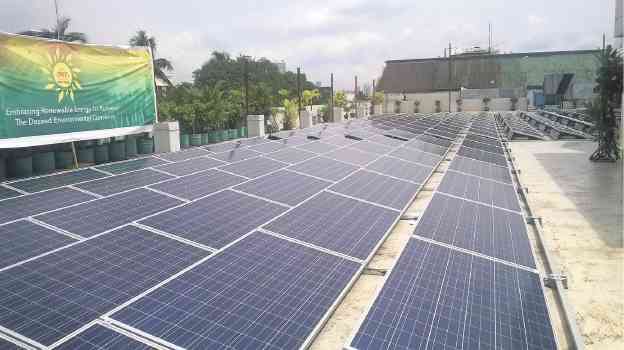Buildings now look to the sun

These panels, numbering 595, now cover most of the roof of Rex Printing Company building in Quezon City
In a step to meet the city’s power demands using 100 percent renewable energy, the state of San Francisco passed in April an ordinance requiring yet to be constructed homes and buildings with 10 storeys or less to have solar panels installed on the roof.
This was the first major city in the United States to have such a requirement.
Indeed, using solar energy for electrical and heating purposes is slowly migrating from being a niche product to nearly an industry standard as more organizations are realizing that utilizing the power of the sun can actually be financially rewarding.
A decade ago, the idea of using solar energy technology sounded radical and politically unrealistic in the Philippines. But this soon changed as solar panels and their installation have become less expensive in recent years.
But while using solar power usually applies to new buildings and those undergoing major refurbishment, the Rex Group of Companies believes even old buildings could benefit from the technology.
Article continues after this advertisementLast October, the Quezon City facility of the group’s subsidiary, Rex Printing Co., officially activated a grid-tied, roof-mounted solar power system—595 photovoltaic modules and ballasted system with seven inverters that could generate 178.5 kilowatt peak.
Article continues after this advertisement
Acting as the backbone of the solar power system, these inverters convert the DC voltage from the solar array into AC voltage that can be either used right away by machinery and appliances or exported to the utility grid.
Smart and efficient
“Activating underutilized roof space is a smart and efficient way to promote the use of solar energy and improve our environment. We need to continue to pursue aggressive renewable energy policies to ensure a sustainable future,” said Eugene Bustamante, property administrator of the group.
The Rex Group of Companies is the umbrella organization of the Rex Printing Company as well as the Rex Book Store, Rex Book Store International, Rex Crown Publications, Rex Digital Publishing Corp., and J&J Properties and Trading Corp.
Bustamente said the installation in its Quezon City facility was just the start as he expects more of their sister companies to also install roof-mounted solar power system.
For Rex Printing Company, its 43-year-old building spends around P1.6 million on electricity bills per month. But this has now changed since the newly activated roof-mounted solar power system allows the facility to enjoy a monthly savings of P200,000 to P320,000.
This development is regarded as a first for a publishing house in the Philippines to utilize solar power technology for its energy requirements.
“As a company whose core business is to produce books and with paper as its raw material, the roof-mounted solar power system is definitely a worthwhile project,” said Rex Group chair and president Dominador Buhain.
Provider
ISO-certified solar solutions provider Green Heat Corp., which installed the roof-mounted solar power system in 155 days, explained that Rex Group’s solar energy initiative reduced the company’s carbon emission by 108 metric tons each year, an equivalent to having saved 1,080 adult trees from being felled.
“We cannot reduce the impact of climate change without transforming global energy systems, but today, we have the unique opportunity to transform not only our company but society as well,” said Don Timothy Buhain, COO of Rex Printing.
The roof-mounted solar power system is not the first sustainable project the group has initiated.
“Previous projects include conversion of the fluorescent lamps to energy efficient LED lamps/bulbs and the installation of the Capacitor Banks through tie up with Meralco to improve the power factor of our energy consumption. Due to the apparent benefit of the roof-mounted solar power system,” informed Atty. Dominador Buhain, the group’s chair and president.
Pioneering act
According to Green Heat director Glenn Tong, manufacturing companies like Rex Printing Company, have the most to gain from going solar because of the nature of their business. “Rex Group’s operation is continuous and therefore requires constant power supply. By becoming a pioneer in using solar to power a portion of its operation is showing other facilities out there that this is the way of the future.”
Though slow to start, the shift from traditional to renewable energy in the Philippines has picked up pace since 2012, after the passage of Republic Act 9513 or the Renewable Energy Act of 2008 that promotes the development, utilization, and commercialization of renewable energy resources.
Among Green Heat’s milestone projects include being the partner of the rural electrification program of the government and installation of roof-mounted solar power system at the Procurement Service-Philippine Government Electronic Procurement System, Asian Development Bank, Asia Brewery, Inc., REDCORP and various Wilcon Depot outlets.
Green Heat has been supporting the government’s renewable energy program for private schools, installing the roof-mounted solar power system of six schools like St. Joseph School of Iloilo; Manuel L. Quezon University-Manila; St. Scholastica’s College-Manila; St. Paul College of Parañaque; St. Scholastica’s Academy-Marikina and Canossa School of Sta Rosa, Laguna.
The company is presently working on a 99.2 kWp roof-mounted solar power system at St. Scholastica’s College-Westgrove at Ayala Westgrove Heights in Silang, Cavite.